Use Zoom to record video
In addition to its use as a virtual meeting space, Zoom is a quick and reliable way to record instructional videos with accompanying visuals and slides. This method works well for short lecture recordings, course introductions, or assignment walkthroughs.
Use MediaSpace links instead of Zoom links
All videos recorded in Zoom are automatically saved to MediaSpace, where they are captioned for accessibility and easy to embed in your Canvas course. MediaSpace also stores videos for 2 years after the last view (while the original Zoom-hosted recordings are only saved for 90 days), making MediaSpace links the best option for sharing videos in courses.
To enable Zoom’s automatic backup to MediaSpace, you must log in to MediaSpace to activate your account at media.pdx.edu . If you’ve used MediaSpace previously, you can skip this step. If you’re unsure, log in to be safe.
The steps below outline the minimum recommended settings. You may need to adjust additional settings based on your specific needs or preferences.
- Sign in to pdx.zoom.us with your PSU Odin credentials.
- From the left-hand menu, select Settings (2).
- At the top of the page, select Recording (3).
- Under Cloud Recording (4) options, check only the following three options:
- Check Record active speaker, gallery view and shared screen separately
- Check Active speaker
- Check Shared screen
- Check Record active speaker, gallery view and shared screen separately
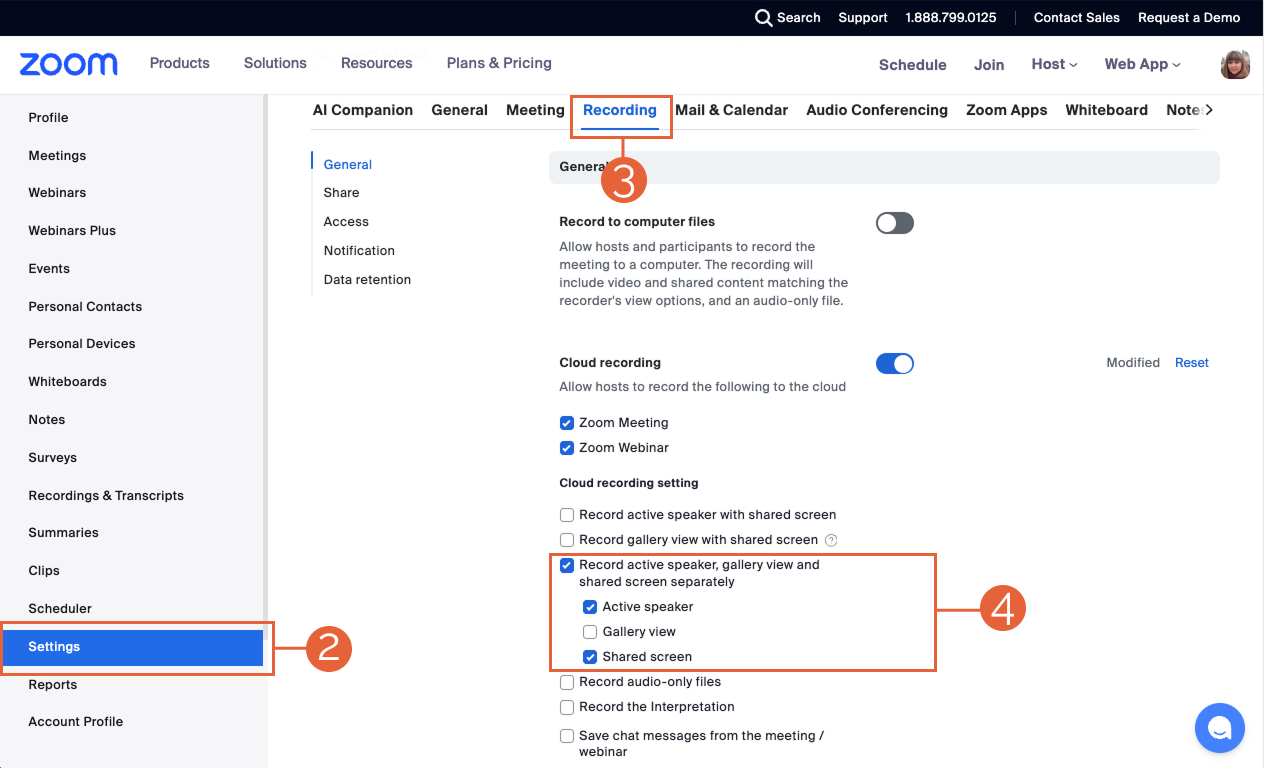
Recording an instructional video in Zoom is just like recording any other Zoom meeting… the only difference is that you’ll be the only person in the meeting! Here are a couple of tips that will help make this process a little easier:
- Name your recording sessions: While you can record in your personal meeting room, scheduling a meeting allows you to give it a unique name, making it easier to find it later in MediaSpace. Consider using a consistent naming format, such as “Course# – Week# – Topic,” to stay organized.
- Record multiple videos: If you want to create several short clips as part of a larger topic, simply start and stop the recording as needed. Afterward, be sure to rename each recording in MediaSpace to reflect its content so you can easily identify it when sharing.
Don’t forget to plan ahead!
Because only minor edits are possible in this workflow, it helps to plan before you record.
- Draft a brief outline or script to guide your talking points.
- Note when you want to display specific visuals or slides.
A little preparation goes a long way toward making your recording session smoother and your final video feel clear, concise, and polished. For more information, visit Create engaging videos.
Your video(s) will automatically upload to MediaSpace after you stop recording in Zoom. Follow these steps to find your video and prepare it to share:
- Log in to PSU MediaSpace.
- Select your name in the upper right corner, and then choose My Media to access your Media library.
- Depending on the length of your recording, it may take a while to show up on your My Media page.
- If you made multiple recordings in the same Zoom meeting, they will share the same title and appear in reverse recording order (the most recent recording will be listed first).
- Once your video appears, review and update the following:
- Rename the video title from its default Zoom title for each recording. (Reminder: Using a consistent naming convention will help you locate videos in the future!)
- Review and edit captions for accuracy.
- Update your media permissions so it’s ready to share.
After you have reviewed your video and made all the necessary updates, you can share it with others via a direct link or embed it in your Canvas course.
This article was last updated Oct 29, 2025 @ 3:54 pm.
Email all students in your course using Google Groups
Email all students using Google Groups
Approximately two weeks before the start of each term, a Google Group is created for each course in Banner. These groups are maintained for 2 terms. You can use your class group to email all students enrolled in your course via your PSU gmail account.
- Sign into your PSU Gmail account from mail.pdx.edu.
- Select compose.
- In the To field, start typing the course code, and look for your course from the auto-complete group options. Verify that you select the correct section and term. The format for the automatic Google group is: course-[department abbreviation]-[course number]-[course section number]-[course year WITH four digit term code]-group@pdx.edu (for example, “course-ling-470-002-201701-group@pdx.edu”)
- Compose and send your email as desired.
For more information, see the OIT article on Google Groups for Classes
You can also use Canvas inbox to easily email your class. Canvas mail forwards messages to and from PSU Gmail addresses, so you can get replies in both Canvas inbox and PSU Gmail.
This article was last updated Dec 11, 2025 @ 3:21 pm.
Flexible teaching strategies

Flexible teaching strategies offer ways to provide content, peer learning, and student inquiry activities that work for in-person, online, or blended learning contexts. In a traditional course classroom activities are synchronous. That includes lectures, discussions, labs, and small group work.Activities that are usually asynchronous include reading, media viewing, and homework.
With technology, teaching strategies that are usually synchronous can become asynchronous and vice-versa. For example, you can break lectures into short videos and have students view them online. Reading can become a peer activity using a shared annotation tool like Hypothes.is. Below are some strategies to help you stay flexible and explore new options.
Flexible teaching strategies for content
Sharing knowledge with students through written and media content is often the backbone of academic teaching. The challenge is to help them care about and question that material in productive ways. Students learn better when they feel your enthusiasm and insight. They’ll also learn more when you connect new ideas with their prior experience and knowledge.
Suggested guidelines
- Deliver or record your presentations in 15 minute “chapters” interspersed with activities. This is particularly important for challenging reading material or presentations. Some examples of what to record:
- Demonstrate a procedure, project, or method of reasoning.
- Show examples of the kind of work you want students to produce.
- Explain abstract content with practical examples or case studies.
- Show students a solved challenge and give them a new, partially-solved problem to complete individually or in groups.
- Present recorded field work, subject-expert interviews, or sample project work.
- Focus on introducing, roadmapping, sparking curiosity, and integrating new material with previous topics and course activities.
- Motivate students by displaying enthusiasm for and showing the relevance of the material to real-world applications and students’ current and future lives. Students learn and remember new material when it’s presented in relation to things they already know (or think they know) about.
- Introduce a new topic by walking through its sequenced components and methods. Build toward increasing complexity. Ideally, teach the steps in the same sequence that students must perform them.
- Give students the most help and rapid feedback early on, followed by prompts for independent inquiry instead of direct instruction.
Note: Explore the wide range of available media and Open Educational Resources. Don’t reinvent the wheel, but address any differences between your perspective or knowledge and those presented in the external media.
Activity ideas
- Use audio or video to record questions and interpretations, or to amplify the course material.
- Identify the theory or idea the material is advancing. Then identify an opposite theory and how that framework presents a different perspective.
- Create a concept map connecting the new material to topics already covered in class.
- List the three most interesting, controversial, or resonant ideas you found in the material and record/write a short rationale for the selection.
- List 10 key words from the material and write/record a summary based on these words.
- Write three substantive questions related to the content and share them with the class.
- Summarize the author’s or presenter’s position or objective. What are its assumptions or preconceptions?
- Identify the main point, and arguments or evidence for and against it.
- Choose three key words or concepts from the material and define them.
- Create a collage or video around the material’s themes, and briefly describe their choices.
Flexible teaching strategies for peer learning
Students create more personalized learning experiences by engaging with each other. They often feel more comfortable asking questions and can gain deeper knowledge by explaining concepts. Peer-to-peer learning is very flexible — it can take place both synchronously and asynchronously.
Suggested guidelines
- Give students a clear understanding of the purpose of paired or group work. It can make students anxious or irritated, but is very effective when students feel it’s relevant and useful.
- Interactions in class are often skewed toward more confident students. You can assign roles or have students change roles to make sure all voices are heard.
- Address grading anxiety by making peer work low-stakes or having each student produce an artifact for individual assessment (not just a group grade).
- Designate time within the weekly workload for students to discuss and collaborate on the group activity.
Activity ideas
- Have students pair up and peer review each step in a multi-step project for feedback and help (“workshop” each incremental step).
- Pair or group students and have each address a different question or challenge. Have them share answers in a Google Doc, a discussion thread, or in synchronous breakout rooms with a shared worksheet that all groups use. This allows groups to observe each other’s work.
- Use pairs or small groups in which each student peer teaches one concept, process, or method in their own words, and gets feedback from their peers. This can be done via Zoom or video recordings.
- Use problem-, case-, or project-based activities divided into clearly defined contribution roles and then workshopped or presented as a group. Grade each contribution individually to reduce anxiety. This can be done via Zoom or video recordings.
- Collaborative written reports in which each student in a group contributes one topic. This is an “authentic” exercise since workplace writing is often team-produced.
- Have students post “One thing I understood well” and “One thing that’s still unclear” in a discussion forum. Use one student’s post as help on a topic. This lets them peer teach and highlights any topics you need to review.
Flexible teaching strategies for student inquiry
Inquiry-based approaches let students discover knowledge rather than having it presented. Discovery generates better learning retention, particularly when assisted by timely guidance (Halpern & Hakel, 2003). Used across disciplines, this approach helps students learn to do scholarship rather than absorb it. Communicating findings is a key part of this process.
Suggested guidelines
- Inquiry learning is question-based rather than thesis-based. Spend time fostering good questions and projects. Help make them relevant to personal, social, or community issues along with course learning outcomes.
- Students formulate new knowledge by associating it with and refining existing knowledge. Make sure you have a good benchmark understanding of what your students know, so you can give them appropriate challenges.
- Give students inquiry or research projects before presenting a full explanatory framework. The students’ work will generate questions, making them want the explanations you present afterwards.
- Inquiry is particularly effective when students can share their plans with other students for discussion and feedback.
- Inquiry is most effective when students have a degree of control over their work. Try letting them choose the specific path or topic they pursue. Give them resources and guidelines instead of step-by-step directions.
Activity ideas
- Have students formulate a question that takes them into their environment to document evidence (social, environmental, aesthetic, political). Field-based experiential inquiry lets students connect their work to a community rather than abstract values.
- Create a media literacy challenge for your course subject. Have students find media examples and create a process to evaluate them.
- Have students write or revise interview questions for a subject matter expert in the community. The interview can be audio, a recorded video meeting, or an email exchange. This can also be an oral history interview.
- Structure a group project or experiment in which each student suggests strategies, and have the group vote on the approach(es) taken. This provides a realistic experience of workplace constraints and collaboration.
- Use a Design Thinking model to research a particular problem (physical, social, environmental), collect data, and create a prototype solution. Have students or groups present conclusions for whole-class discussion.
- Have students find a historical artifact relevant to your course topic and analyze it using a rubric.
Halpern, D. F., & Hakel, M. D. (2003). Applying the Science of Learning to the University and Beyond: Teaching for Long-Term Retention and Transfer. Change, 35(4), 36–41.
Learn more elsewhere
Websites
- OIT's Classroom Technology Guide (PSU)
- Collaborative Learning and Peer Learning (Penn State)
Resources
- Annenberg Classroom Resources
- Bozeman Science Resources (introductory science)
- Google Arts and Culture (includes maps of museums to digitally explore)
- MERLOT Collection of Teaching Materials
- NYPL Digital Collections
- Media History Digital Library
- Carleton University Cooperative Learning Activity Library
Import a Scheduled Zoom Meeting into Canvas
Import a Scheduled Zoom Meeting into Canvas
In most cases, you will set up Zoom meetings for your class directly in Canvas. However, in some cases you may need to import a Zoom meeting you created outside of Canvas into a Canvas course. Importing a meeting into the Canvas course ensures that students have direct access to the Zoom meeting and any associated recordings automatically through the Canvas course.
This method can only be used to share a meeting with one Canvas course. If you want to share a meeting with multiple courses, the meeting invitation link must be posted elsewhere in Canvas, such as in an Announcement.
- Log in to Canvas.
- On your Canvas Dashboard, select the course and then Zoom (1) from the course navigation.
- Select the blue All My Zoom Meetings/Recordings (2) link in the upper right corner.

- Find the meeting you want to share with students. Select and copy the Meeting ID (3)
- Above your meeting list, select the blue Course Meetings/Recordings link (4)
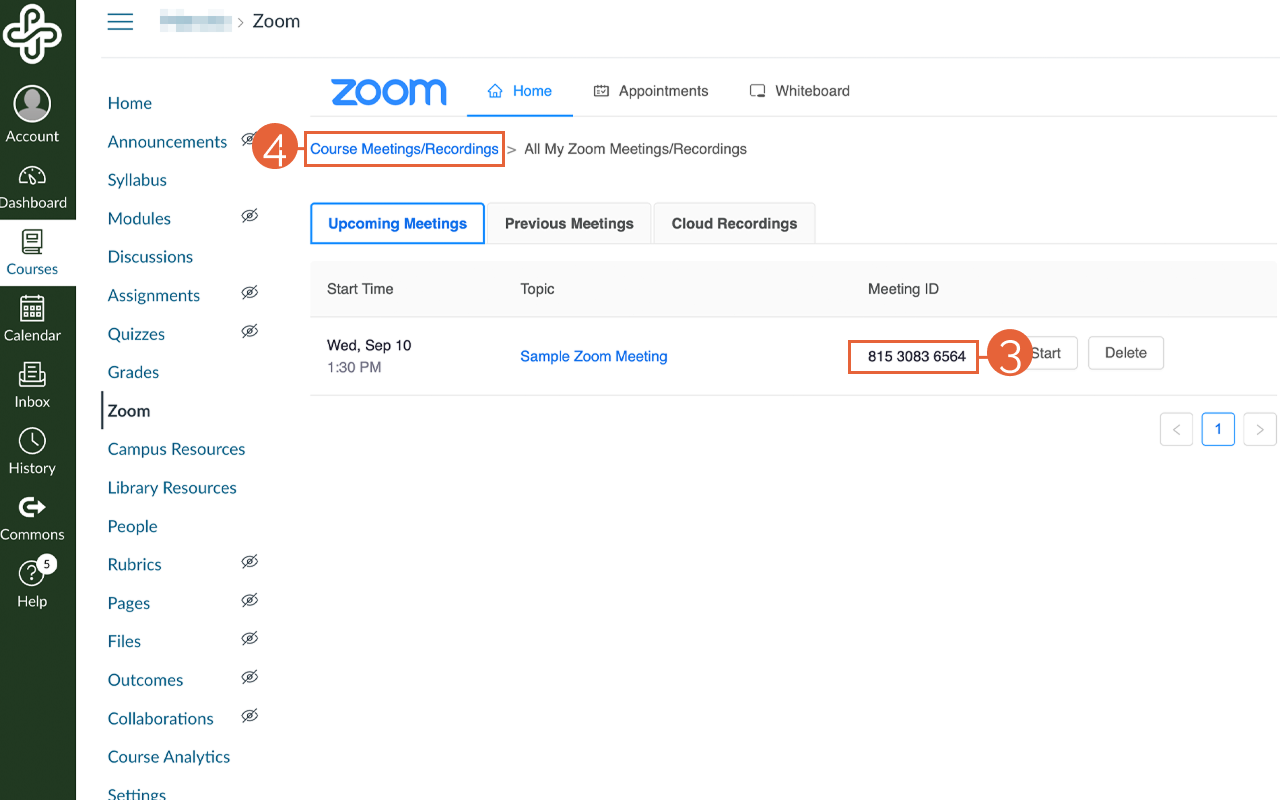
- In the upper right corner of this screen, to the right of the blue Schedule a New Meeting button, there is a small square with three vertical dots (5). Select that and then choose Import Meeting (6).
- In the small pop-up window, paste in the meeting ID (7).
- Select the Import button (8). The meeting link will now be visible to students in the course.
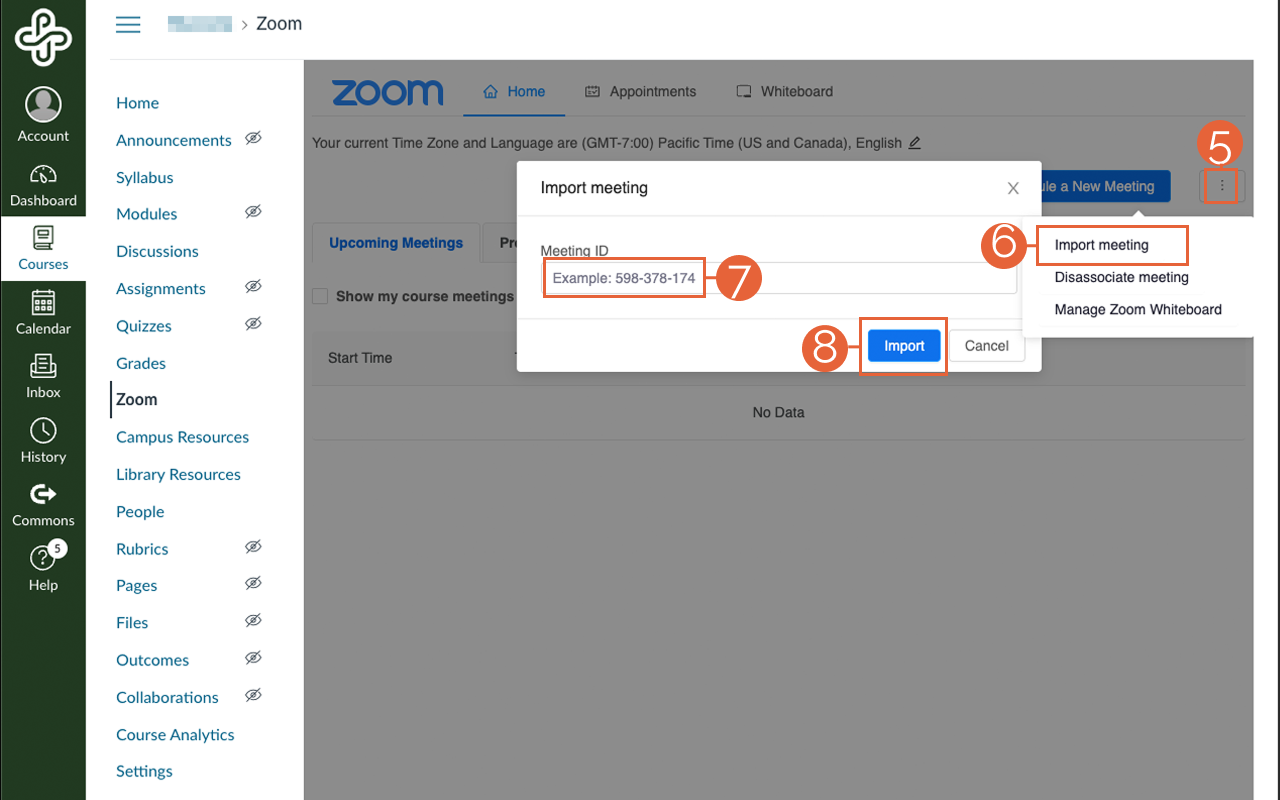
This article was last updated Oct 9, 2025 @ 2:50 pm.
Zoom Webinars at PSU
- Home
- Articles Posted by
Zoom Webinars at PSU
Zoom Webinars are available at PSU by purchasing event support services from OIT’s AV Events for a fee. Due to the complexity of supporting and running a webinar, PSU does not currently have webinar licenses available for DIY use. If you would like to pay for a Zoom Webinar Event, please visit Campus Event AV.
Zoom Webinars are available at PSU by purchasing event support services from OIT’s AV Events for a fee. Due to the complexity of supporting and running a webinar, PSU does not currently have webinar licenses available for DIY use. If you would like to pay for a Zoom Webinar Event, please visit Campus Event AV.
Will a Zoom Meeting meet my needs?
We have found that many of the needs described in webinar requests can be met by a Zoom Meeting. All active PSU users have access to a Zoom Pro/ Licensed account, which allows them to host Zoom Meetings of any duration and with up to 300 participants. Up to 200 participants can be in up to 50 breakout rooms in a Zoom Meeting. 100 other participants can be in the main room while 200 are in breakout rooms.
Participation in Zoom Meetings vs. Webinars
Meetings
Meetings are designed to be a collaborative event with all participants being able to screen share, turn on their video and audio, and see who else is in attendance. Control of a meeting offers many options in the host’s Zoom settings, as well as facilitation techniques.
Zoom meetings are ideal for hosting more interactive sessions where you’ll want to have lots of audience participation or break your session into smaller groups.
Webinars
Webinars are designed so that the host and any designated panelists can share their video, audio and screen. Webinars allow view-only attendees. They have the ability to interact via Q&A, Chat, and answering polling questions. The host can also unmute the attendees. Attendees in webinars, can not rename themselves as well.
Think of webinars like a virtual lecture hall or auditorium. Webinars are ideal for large audiences or events that are open to the public. Typically, webinar attendees do not interact with one another. Though Zoom provides options for you to get more social with your attendees, your average webinar has one or a few people speaking to an audience.
If you think you’d like a webinar, please review this Zoom Meeting and Webinar Comparison article.
Size-based indicators for Zoom modality
How many people will be attending your event? If less than 300, what features are you interested in that indicate webinar use rather than a Zoom Meeting?
What style of participation is needed? If 300-500, a Zoom Webinar may be needed. Not all features of a Zoom Meeting are available in a Zoom Webinar.
What style of participation is needed? If a Zoom Webinar is needed, it is available by purchasing Event AV Services from OIT for a fee. If 500+, a Zoom Webinar for 500 participants plus streaming of the webinar for the overflow audience may meet your needs.
What style of participation is needed? If a Zoom Webinar is needed, it is available by purchasing Event AV Services from OIT for a fee.
Nearly all academic use cases can be met using Zoom Meetings and a standard PDX Zoom pro license — the account you access at pdx.zoom.us.
Frequently Asked Questions about Zoom Webinars at PSU
How long can meetings be?
PDX Zoom meetings can be as long as you need. If you’re running into a time limit, check to make sure you’re logged in to your account with your PSU Odin information at pdx.zoom.us. Contact OAI Faculty Support if you continue to see a limit.
How many people can join a meeting?
Up to 300 participants can join PDX Zoom meetings. If you’re using breakout rooms, you can have 200 participants across 50 different breakout rooms. If you see a lower participant limit, check to make sure you’re logged in to your account with your PSU Odin information at pdx.zoom.us. Contact OAI Faculty Support if you continue to see a lower limit.
How can I manage invitations?
You can use the meeting registration function to set up a landing page with customized questions and the ability to send a customized registration email to your guests ahead of the meeting. This is not a recommended setting for classroom Zoom use, as it can add a barrier for students to join meetings. However it can be a valuable feature for non-class meetings.
How can I manage participants during the meeting?
Zoom has a number of features designed to help you manage meeting participants including chat, the ability mute all participants, and remove individual users. The short video below outlines how to use these features.
How can I use advanced interactive features (polling, hand raising, screen sharing, etc.)?
You can create meeting polls in advance, which you can launch during a meeting to add interactivity or ask participants questions. Participants can signal a hand raise, yes, no, or give other feedback with the nonverbal feedback feature in meetings. You can share and annotate your screen or a virtual whiteboard.
How can I know who came to my meeting?
Use the participant reports function to see details about who joined your meeting and how long they stayed.
This article was last updated Jun 12, 2025 @ 3:35 pm.
View Zoom Meeting Attendance
View Zoom Meeting Attendance
You can view Zoom meeting attendance in participant reports for meetings you have hosted. Reports are available starting 30 minutes after the meeting concludes. The report includes a log of all participants in the meeting, including timestamps of when they entered and left the meeting.
- Log in to your full Zoom account with your PSU Odin at pdx.zoom.us
- Select Reports (1) from the left navigation menu.
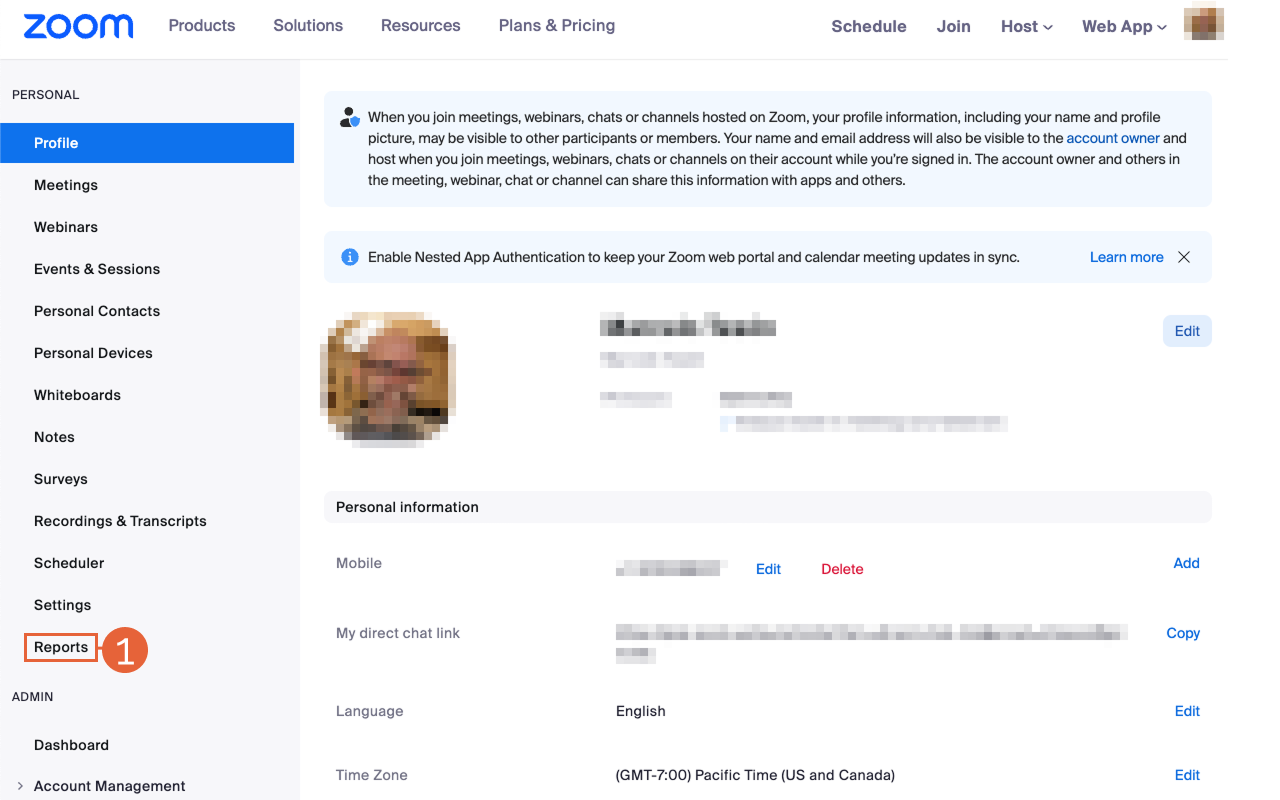
- Select Usage Reports (2) from the available options, and then Meeting and Webinar History (3)

- Find your meeting from the list of prior meetings. If it is not a recent meeting, you may need to adjust the time period searched.
- Click the participant number corresponding to your meeting (4). If you do not see the participant column, try scrolling right.
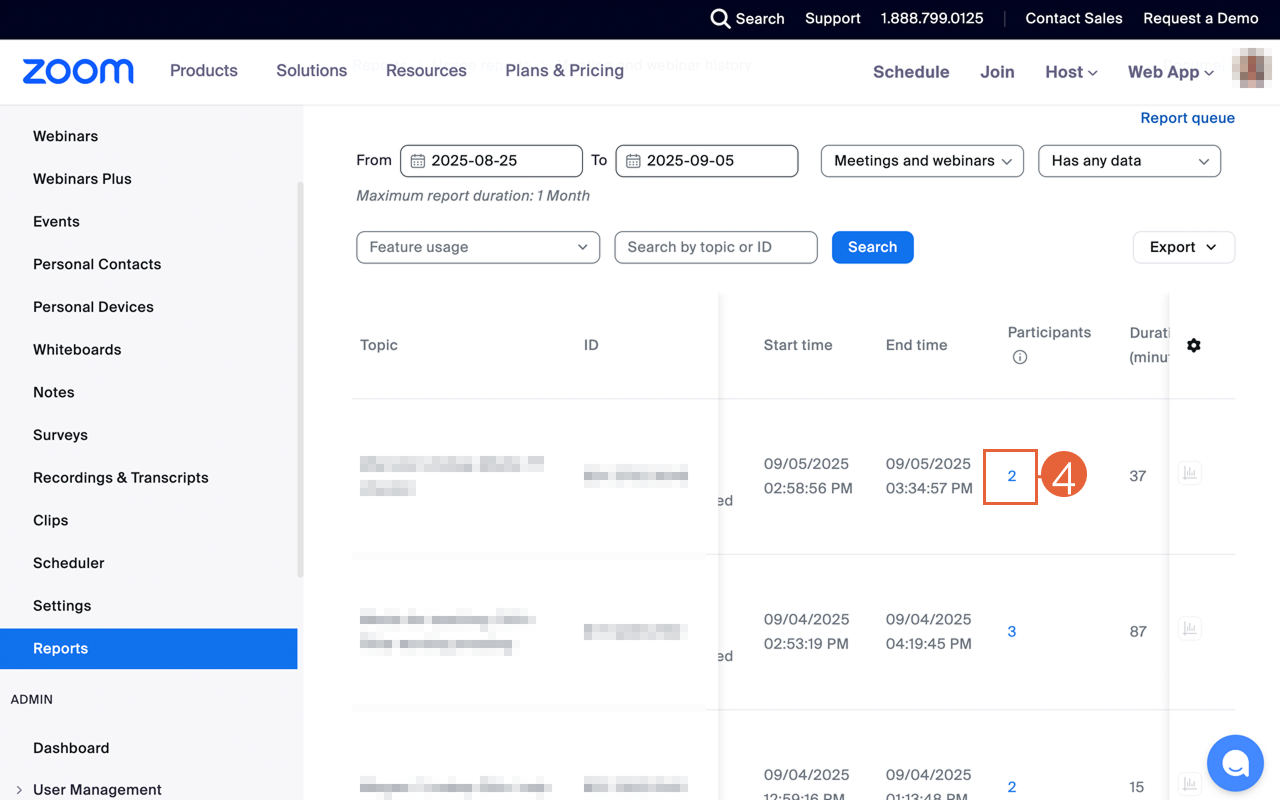
- This will open a Meeting Participants report. Note that a participant will be counted multiple times if they left the meeting and re-entered.
- Optionally export the report to CSV for easy sorting, filtering, and reference.
This article was last updated Oct 7, 2025 @ 4:15 pm.
Videoconferencing, Recording, and FERPA
Videoconferencing, Recording, and FERPA
The Family Educational Right and Privacy Act (FERPA) of 1974 (Public Law 93-380), affords students certain rights with respect to their educational records and requires Portland State University to assure that those students’ rights are not abridged. FERPA protects the privacy of all “education records,” in any medium, maintained by Portland State University.
Class recording FERPA guidance for faculty
FERPA restricts the sharing of student records information, including student class-activities. To maintain FERPA compliance with classroom recording, it’s imperative that any class recordings which include any student activity are shared only with students, TAs, and instructors who are in the same class as the recording. Class recordings may not be reused across classes or sections.
Any recordings of students engaged in any class activities is subject to FERPA prohibitions and should not be shared beyond the class. Student class activities can include student names, voices, photo or video, and chat activities. Class recording content can not be shared outside of the class without a FERPA release from all parties.
For more information about FERPA, see the FERPA Tutorial and FERPA FAQs maintained by the Office of the Registrar.
Syllabus statement for class recordings
We will use technology for virtual meetings and recordings in this course. Our use of such technology is governed by FERPA, the Acceptable Use Policy and PSU’s Student Code of Conduct. A record of all meetings and recordings is kept and stored by PSU, in accordance with the Acceptable Use Policy and FERPA. Your instructor will not share recordings of your class activities outside of course participants, which include your fellow students, TAs/GAs/Mentors, and any guest faculty or community based learning partners that we may engage with. You may not share recordings outside of this course. Doing so may result in disciplinary action.
What about recorded lectures?
Faculty recordings of themselves which do not contain any student information or activities are not governed by FERPA and can be shared across classes and sections. Instructors may wish to record lectures for multiple sections or terms and share those recordings across sections. This is acceptable so long as recordings do not include any students. For tips on recording your Zoom meetings without capturing students, see Zoom Recording and Student Privacy.
This article was last updated Jul 10, 2025 @ 9:55 am.
Set media permissions and share via URL
Set media permissions and share via URL
How do I set permissions?
- Log into media.pdx.edu
- Select the button with your name on it in the upper right corner, and then select My Media.
- Find your video in the list, and select the title of the video. This will take you to the video’s specific page.
- Find the Actions (1) dropdown menu below the video:
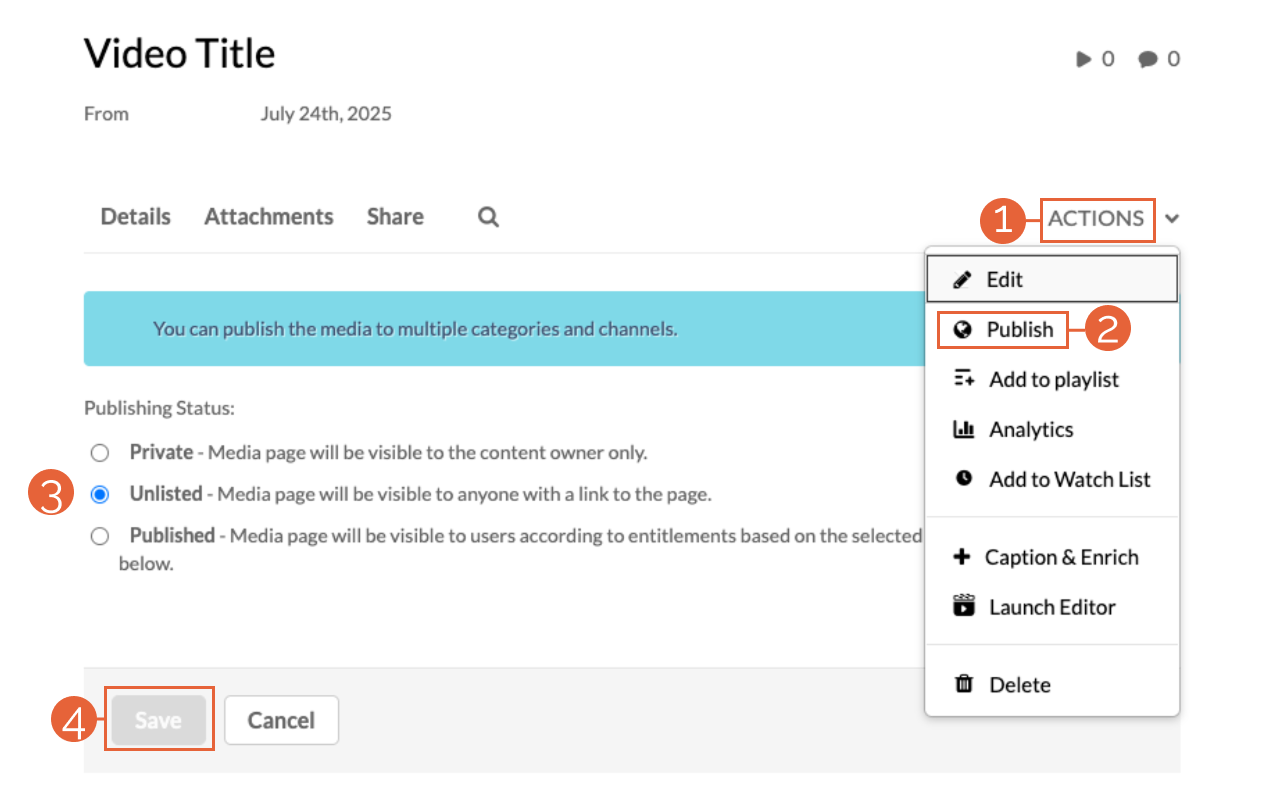
- Select the Publish (2) option in the menu list. See permissions options below.
- To share media, set to Unlisted (3).
- Select Save (4).
- Select the Share tab below the video.
- Copy the web address from the Link to Media Page tab. This is the link that can be shared with others.
Media permission options in MediaSpace
- Private: Private media is viewable in your account only. No other account can see a private video.
- Unlisted: An unlisted video is viewable by anyone with the direct link. This is the recommended setting for sharing videos with your students.
- Published: If you need to set highly specific access to a video, you can create a channel, and publish a video to that channel. Learn more about channels in Create a Channel.
This article was last updated Aug 11, 2025 @ 11:43 am.
Download Media from MediaSpace
Download media from MediaSpace
By default, media added to MediaSpace is not available for download. However, the media owner can enable downloading. Once enabled, anyone who can view the media file can also download it. If you don’t want that, after downloading the file you can disable download.
How do I download media?
- Begin by logging into media.pdx.edu.
- Select your name in the upper right corner
- Select My Media from the menu.
- Find the media file you wish to download from your list. Select the small pencil (1) icon to the far right of that file. This opens the Edit Media Page, where you enable downloading.
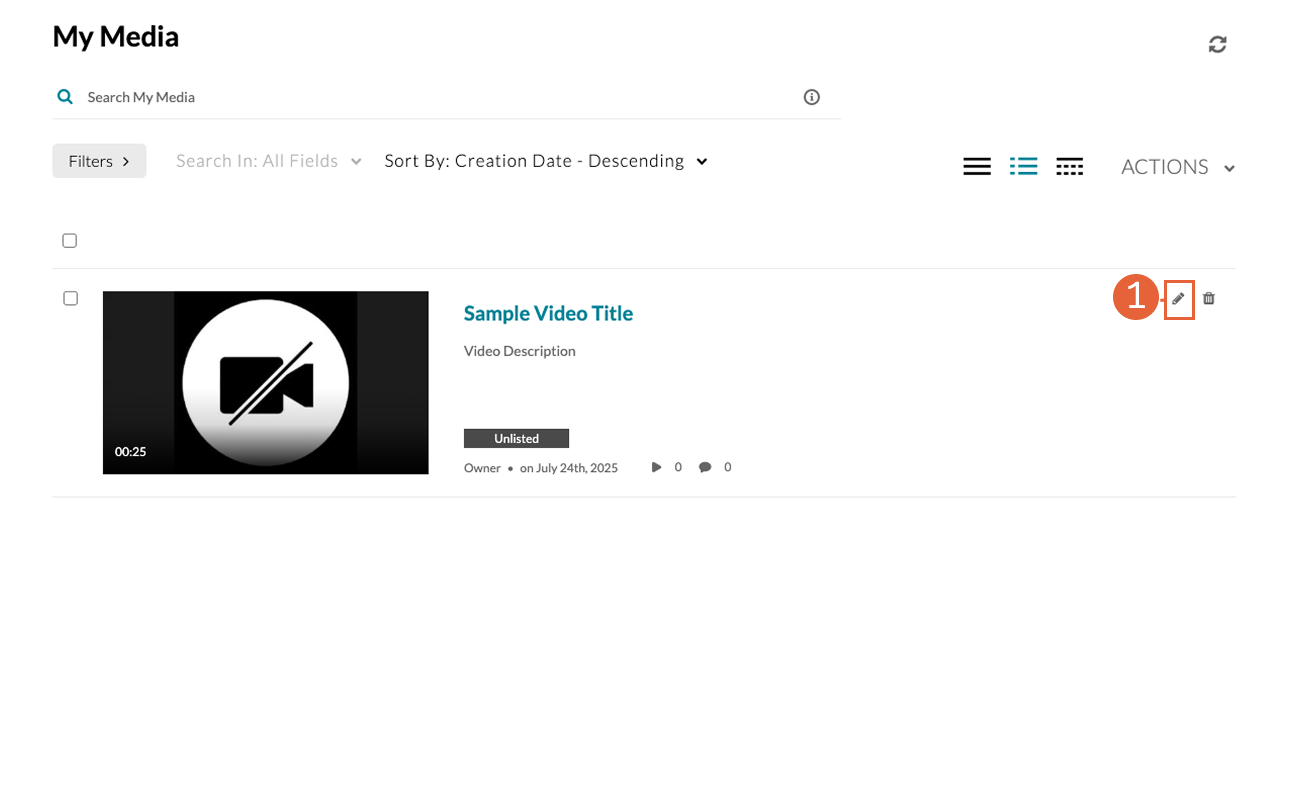
- Select the Downloads (1) tab.
- Select the Source (2) checkbox to enable downloading for this file.
- Select Save. (3)
- Select Go to Media. (4) This opens the Media Entry page, where you download the file.
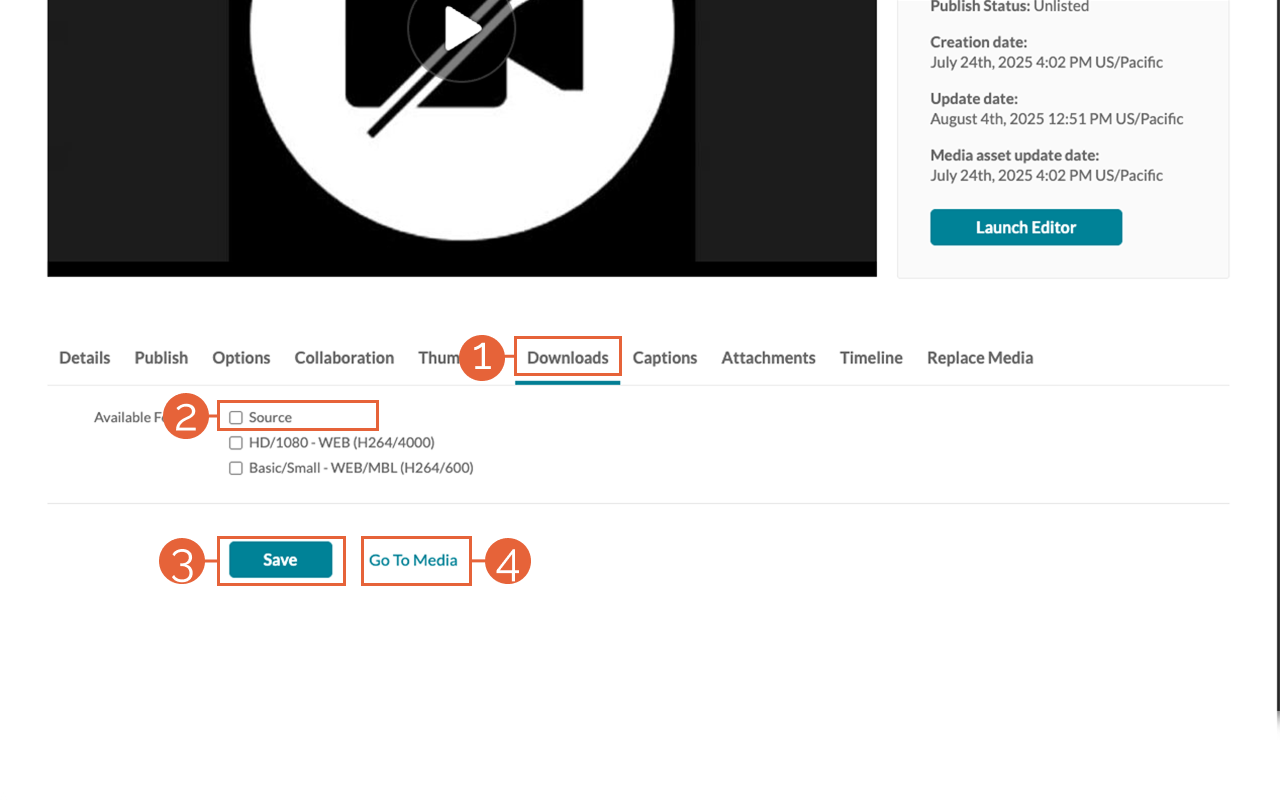
- Select the Downloads (5) tab.
- Select the download icon. (6)
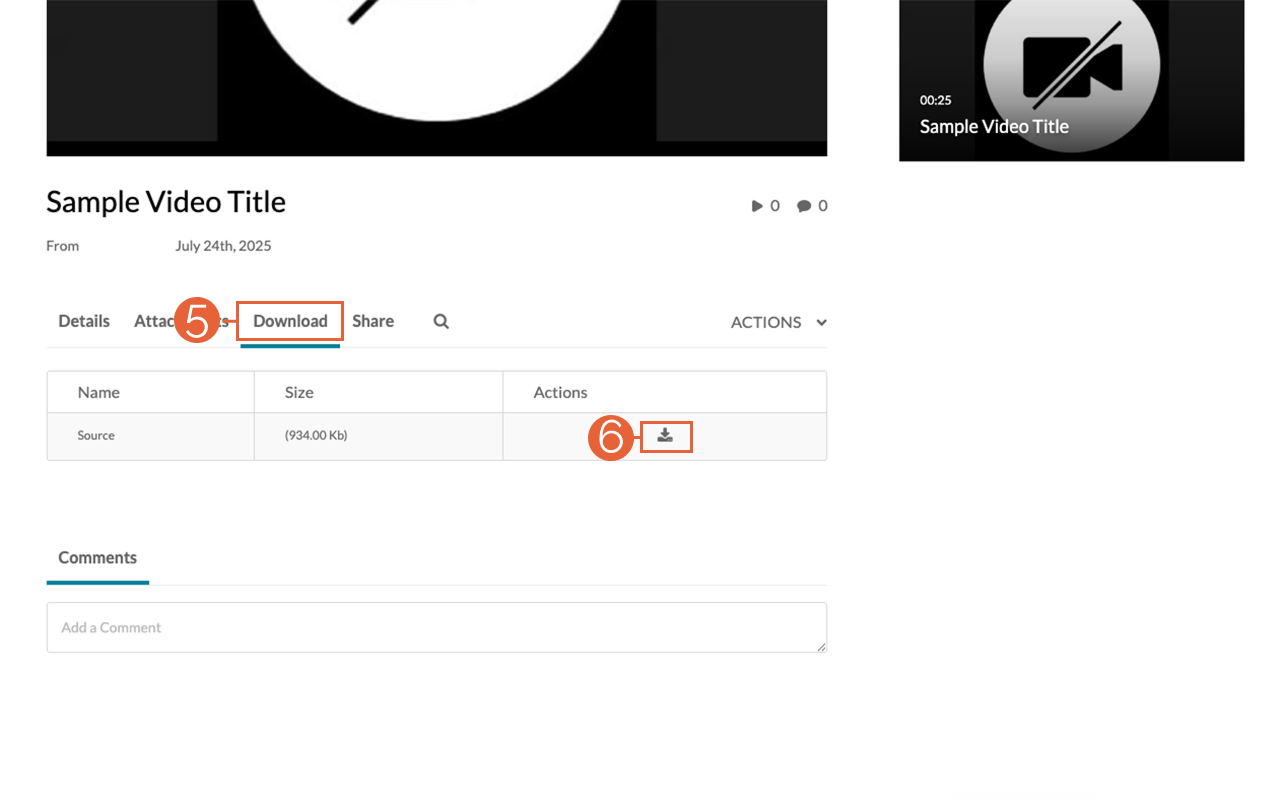
Disable download (optional)
If you wish to disable downloading your video (for example, after downloading a copy for yourself or making it available on a temporary basis), return to your My Media page by selecting your name in the upper right corner and selecting My Media. Then select the pencil icon to the right of your media file just as before. This will return you to the Edit Media Page. From there:
- Select the Downloads tab.
- Uncheck the Source button.
- Select Save.
This article was last updated Aug 11, 2025 @ 11:56 am.
Use Your Zoom Personal Meeting Room for Office Hours
Use your Zoom personal meeting room for office hours
You can use Zoom’s Personal Meeting Room feature to have a dedicated URL to use for virtual office hours on demand. This functionality makes it easy to share a single URL to use across terms and classes, without the need to schedule individual Zoom sessions for scheduled office hours.
Note: to schedule office hours with your Zoom Personal Meeting Room, you need to schedule directly in the Zoom Desktop App or the Zoom portal at pdx.zoom.us and then import the meeting to the Canvas Zoom area.
- Sign in to the Zoom web portal at pdx.zoom.us with your PSU Odin.
- Select the Meetings (1) link on the left navigation.
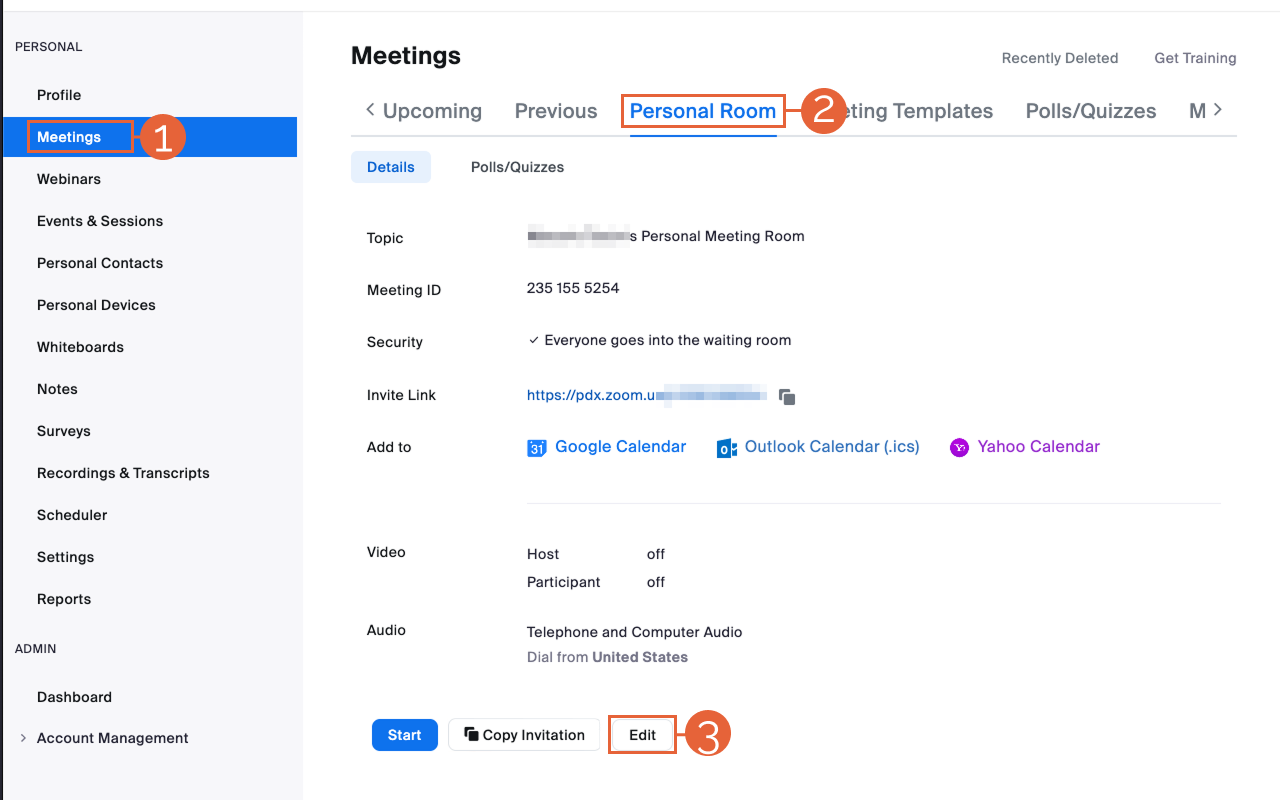
- Select the Personal Room (2) tab from the top navigation.
- Scroll to the bottom of the page and select the Edit button (3).
- For office hours, we recommend the following Meeting Options:
- Enable Waiting Room. This means you will need to allow individual participants to join the meeting one-by-one. This is critical to maintain student confidentiality and meet FERPA requirements.
- Enable Require authentication to join.
- Restrict to Signed in with a Portland State account (Odin).
- Next to the word Options, select Show (4) and make sure “Allow participants to join anytime” is unchecked. This prevents anyone from entering your Zoom meeting unless you are in there first.
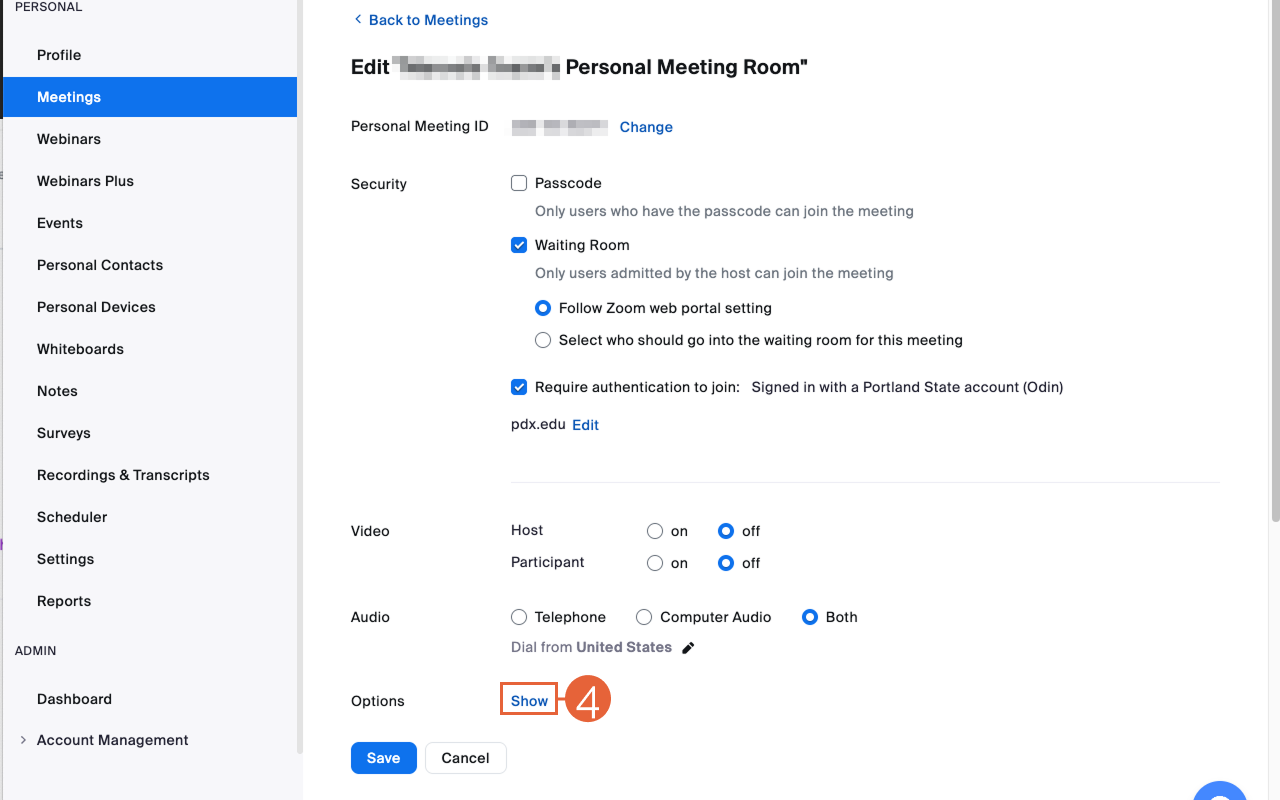
- Adjust other meeting settings as desired. (See recommended settings for preventing Zoom-bombing.)
- Save when done.
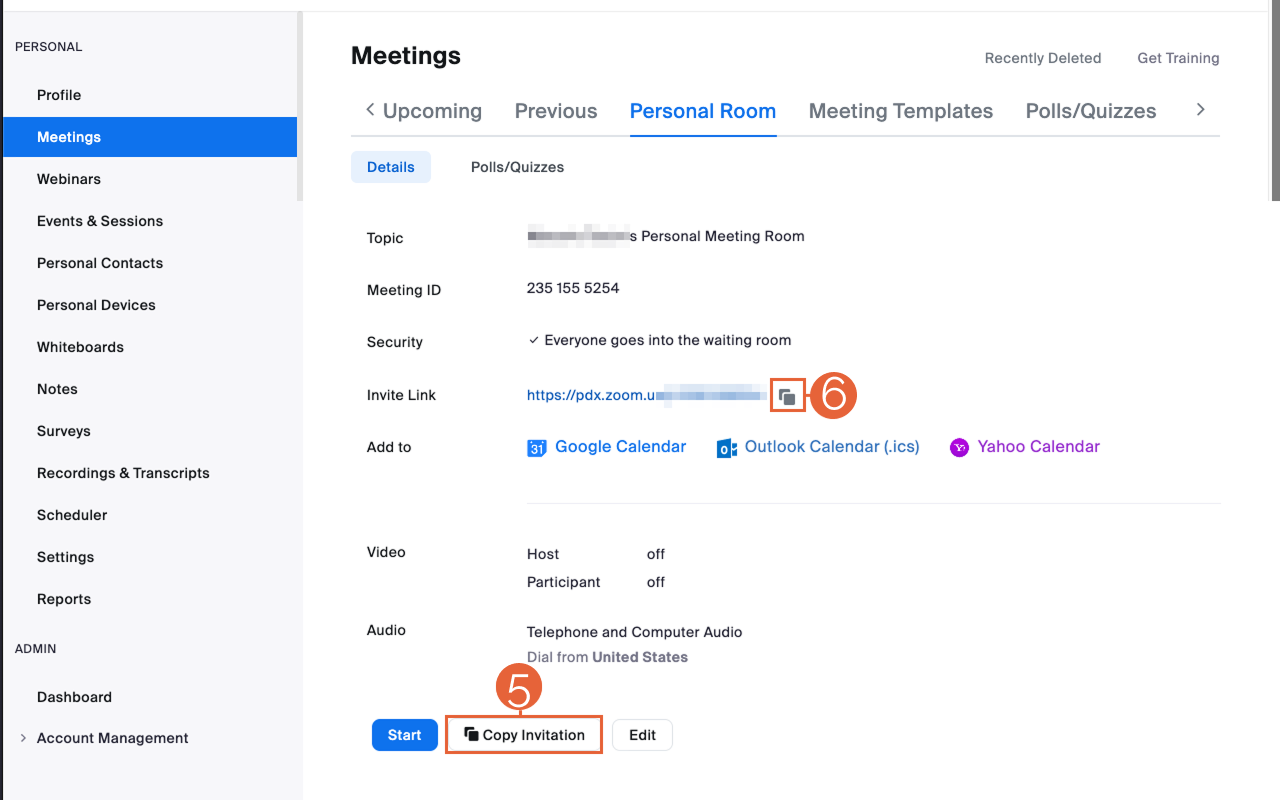
- Select Copy Invitation (5) to copy the full invitation (including additional phone access number) to your clipboard. You can also copy just the invitation URL by selecting the copy icon (6) next to the URL itself.
- Share the invitation with students as your office hours location.
Students will be able to visit the link at any time, but will be in a holding space until you start the meeting. Once you start the meeting, students will be in the waiting room until you let them into the meeting. You may receive “Your Attendees Are Waiting” email notifications when students click the URL if you are not in the meeting.
This article was last updated Oct 9, 2025 @ 1:39 pm.






